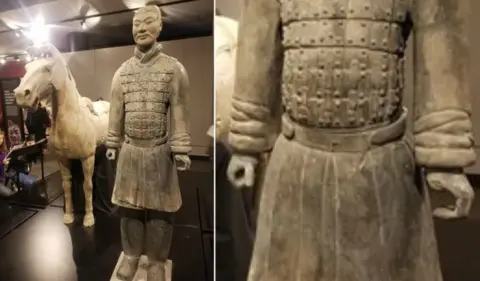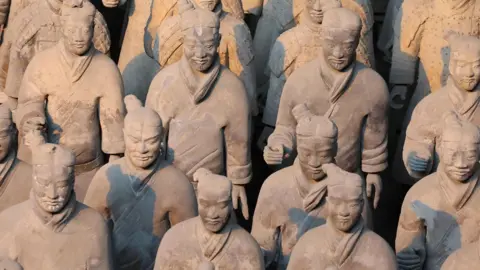Terracotta theft: Chinese anger over stolen warrior thumb
 TripAdvisor
TripAdvisorChinese authorities have demanded "severe punishment" for a man who allegedly stole the thumb of a terracotta warrior statue on display in the US, Chinese state media report.
The 2,000-year-old statue, worth $4.5m (£3.2m), is one of 10 on loan to the Franklin Institute in Philadelphia.
Last week, Michael Rohana was charged with theft and concealment of a major artwork, and later released on bail.
The Terracotta Army is one of China's most important archaeological finds.
A selfie and a theft
According to court documents, Mr Rohana, 24, was attending an Ugly Sweater Party at the Franklin Institute on 21 December when he made his way into the Terracotta Warriors exhibit, which was then closed.
Mr Rohana allegedly used a mobile phone as a torch and took a selfie with one of the warriors, according to Chinese state media Xinhua, quoting the FBI.
He then allegedly put his hand on the left hand of the statue and appeared to break something off from it. He pocketed the item and left.
Museum staff noticed the missing thumb on 8 January and the FBI later traced it to Mr Rohana. He later admitted that he had kept the thumb in a desk drawer.
On Monday, the director of the Shaanxi Cultural Heritage Promotion Centre, the government-run organisation which loaned the statues out, "strongly condemned" the Franklin Institute for being "careless" with the statues, CCTV reported.
"We ask that the US severely punish the perpetrator. We have lodged a serious protest with them," said Wu Haiyun.
Mr Wu said the centre would be sending two experts to the US to assess the damage and repair the statue with the recovered thumb. There would be a claim for compensation, he added.
 AFP
AFPThe 10 statues currently on display at the Franklin Institute are part of an army of 8,000 life-size clay warriors which make up the Terracotta Army.
The statues were built by the Chinese emperor Qin Shi Huang, who died in 210 BCE, and who believed they would protect him in the afterlife.
They were discovered in China's Xi'an city in 1974 by a group of Chinese farmers.

What other cases have there been of historic artefacts being vandalised?
- In 2009, the infamous Arbeit Macht Frei sign at Auschwitz was stolen from the death camp by three men who were later sentenced to prison terms. The sign was recovered several days after it was stolen, however it had been cut into three pieces
- The world heritage site of Easter Island was subject to vandalism in 2008 when a Finnish tourist damaged a famous statue by clipping off an ear. The uproar led the mayor of Easter Island to say on public radio that he wished the tourist would get his ear clipped off too
- A Chinese teenager vandalised an Ancient Egyptian artwork at the Luxor temple in 2013 by writing "Ding Jinhao was here" in graffiti at a Luxor temple complex

